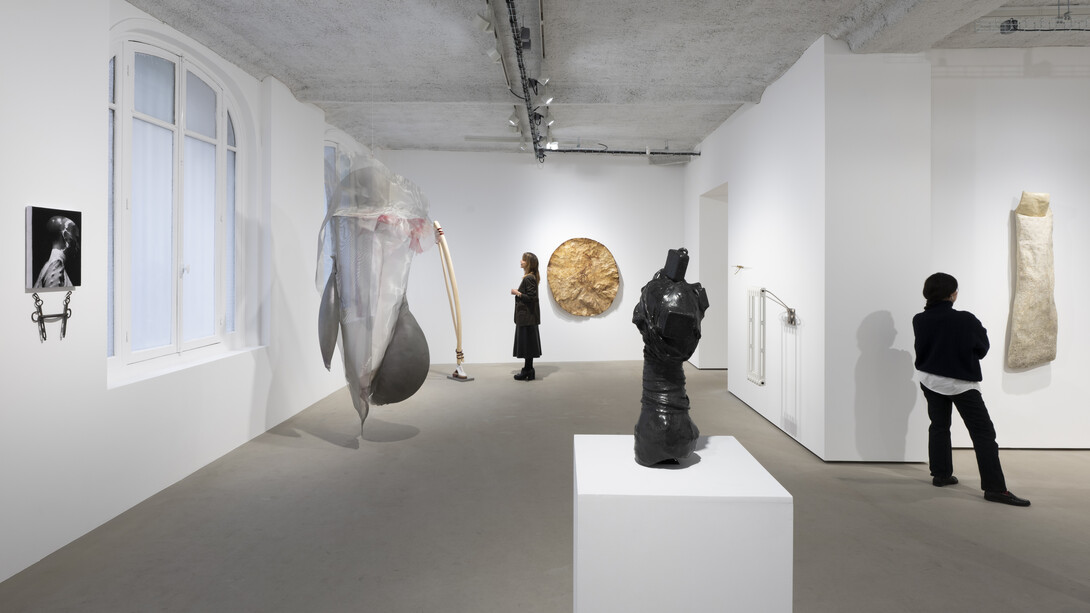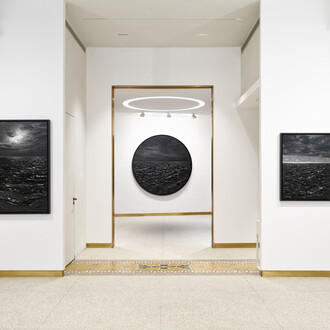Goddess of the sky, protector of astronomy and geometry, daughter of Zeus and Mnemosyne, Urania is also the title of a cult science fiction book series lauched in the early 1950s by the Italian publishing house Mondadori. Guided by the formal language of science fiction and interwoven with fragments of the sky, this first collective exhibition in our new space is conceived as a research- based project, bringing together a constellation of contemporary artistic propositions that explore the field of sculpture and foster intergenerational dialogues between artists.
Tête noire 2 (2025) by Diego Bianchi is one of the artist’s first bronze works, shown here for the first time. It was created by fusing together various discarded elements — some found on the street — as a reflection on overconsumption: computer cables, fragments of electronic objects, and so on.
Katinka Bock presents three new pieces, sculptural collages that, in one case - Horloge (2025), evoke the game of balance and tension so dear to the artist, and in the others (Cardiogram I (2025) and Cardiogram II (2025)), the relationship between mechanical or domestic elements and the human body.
Weeping rock (2025) by Brazilian artist Paloma Bosquê plays on the illusion of a rock made entirely from non-mineral materials (cotton fiber, layers of resin), and of a fountain whose shape arises directly from the connection between geological nature and the female human body.
The use of stained glass is a common thread running throughout the work of Ukrainian artist Daria Koltsova, who explores themes shared with the previously mentioned artists. Witnesses (2024), a pair of black sunflowers, plays with the reflections between the two large flower/shields; Cracks (2024), metal buckets whose liquid contents have been replaced by stained glass suggesting both the surface of water and fracture; and the Toys series (2025), created during her residency at the Domaine des Oseraies, features knives made from shards of stained glass, their sharp violence softened by the seductive play of color and iridescence.
muses (2025) is a work by Daiga Grantina made from synthetic materials that evoke biological forms such as “buffs,” inflated counter-shapes covered in fabric, suspended by metal mesh. Without any direct natural reference, muses (2025) evokes an iconographic register close to that of science fiction book illustrations.
Isa Melsheimer’s ceramic suspension entitled Feston I (2022) refers to garlands of fresh or sculpted flowers and leaves used as architectural ornamentation, while also evoking the forms of a rosary, a spine, or a vine.
The two works by Annie Quéméneur Lauras, La grande hostie (2020) originating from animal parts (the mare’s placenta and animal glue) and La pierre fertile (2015) originating from minerals (chalk mixed with animal glue), attest to the artist’s deep connection to the earth and the agricultural world, whose raw materials she sublimates into abstract compositions created through layering and stratification.
SR 47348 (2024), the title of Chloé Royer’s piece, is also the name of a prototype shoe that forms part of the work and reflects the artist’s long-standing friendship and collaboration with Salomé Burstein (Shmorévaz). The carved wooden legs wearing the prototype — evoking both bone and flesh — are held together by silicone straps and outline the shape of a headless body; a body without a full presence but defined solely by its potential for movement.
Christoph Weber is fascinated by the qualities of concrete — drawn to its malleability, processability, and creative potential. In these specific works on show, the concrete forms reminiscent of this typical sculptural language are contrasted with beeswax as a base, an entirely different yet equally malleable and durable material, creating a striking and tactile contrast.
The preferred technique of Shanghai-based artist Yunyao Zhang is freehand drawing on felt. Study in Portraiture 4 (after Temple of love by Rick Owens) (2025) and Hypothesis on evolution (2025) are two of the exhibited works created using this technique. The first belongs to a series inspired by fashion designer Rick Owens’ recent exhibition at the Palais Galliera; the second, evoking a David Cronenberg–like universe, depicts an alien being (spine, jellyfish, phallus) accompanied by its study drawing on paper. The fourth work exhibited, also titled Hypothesis on evolution (2025), presents an image inspired by Modigliani and Brancusi’s Cycladic forms, completed with the collage of a dried plant collected in Portugal.












